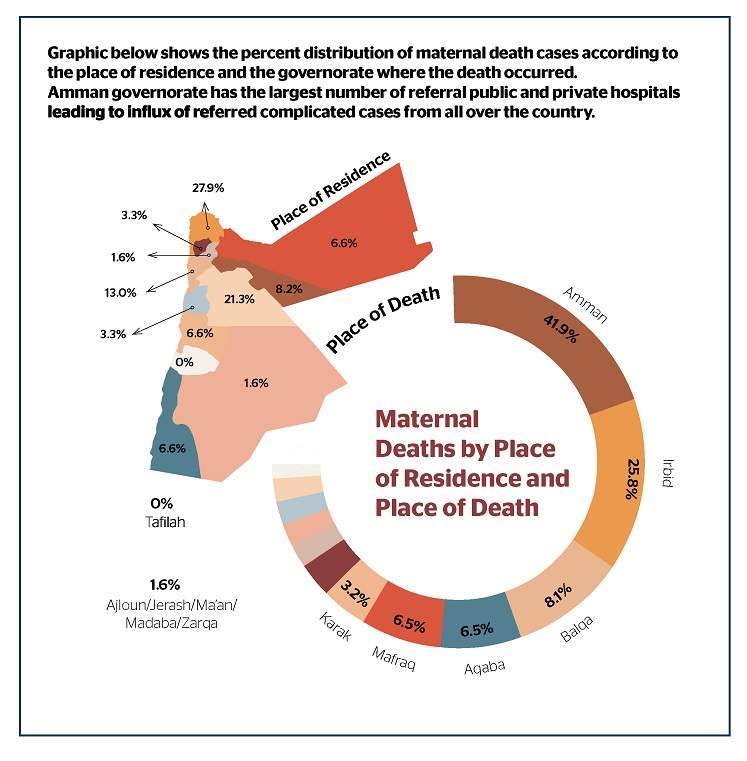Maternal health is defined as health during pregnancy,
childbirth, and the post-childbirth period. According to the WHO, 295,000 women
died during or following pregnancy in 2017 alone.
اضافة اعلان
Maternal deaths are considered preventable through better
supervision by skilled health professionals and a supportive environment.
Problems may arise during pregnancy that can lead to complications if not
managed correctly, which is why maternal health is essential to preventing
these complications.
To ensure maternal health is taken seriously, more effort
should be put forth to increase awareness and encourage women to speak to their
doctors about any issue that may arise during pregnancy.
Maternal health is essential to preventing the tragedy of
losing a mother or a child and reducing the negative effects families can face.
Therefore, maternity care should be improved to encompass the entirety of the
process from pregnancy to postnatal care.
Maternal health
conditions
A variety of conditions can arise during pregnancy,
childbirth, and post-pregnancy that may lead to complications if not managed
and treated correctly. Some of these to look out for are:
Anemia: Iron levels should be checked by
your healthcare provider regularly during pregnancy. Having a lower than average number of healthy red
blood cells due to pregnancy can lead to a weak or fatigued feeling. This can
be treated by taking iron and folic acid supplements as recommended by your
doctor.
Urinary tract infections (UTIs): healthcare providers often
test urine in the early stages of pregnancy to treat any infections
appropriately. Pregnant women must keep an eye out for any symptoms such as
pain or burning while urinating, needing to urinate more often, and any fever
or excessive tiredness. Symptoms must be reported immediately to a healthcare
provider so they can take the proper action.
Hypertension (high blood pressure): If not
managed correctly, high blood pressure during pregnancy puts the mother and her
baby at risk. It can lead to many complications such as preeclampsia (damage to
organs such as the liver and kidneys), placental abruption (placenta separates
from the uterine wall), and gestational diabetes. If you have any issues with
blood pressure before a pregnancy, they must be discussed with your doctor.
Blood pressure during a pregnancy should be monitored regularly.
Diabetes: Elevated blood sugar can be a
problem for both the mother and her baby during pregnancy. Diabetic women must
discuss with their doctors a routine to monitor their blood sugar. High blood
sugar during conception increases the risk of congenital disabilities,
stillbirths, and preterm birth. Many women develop diabetes during pregnancy.
This type of diabetes is referred to as gestational diabetes, which can impact
the mother and the child. It can be managed typically by diet and exercise
recommended by your doctor.
Hyperemesis gravidarum (extreme persistent nausea and
vomiting during pregnancy): Morning sickness is normal with most pregnancies;
however, if it persists, it can lead to health problems for the mother, such as
severe dehydration and poor weight management. In rare cases, it may also cause
esophageal bleeding. Talk to your health care provider if nausea and vomiting
are severe and persistent.
Reform in
Jordan
Having an accurate maternal mortality ratio (MMR) is vital
to determining the level of maternal health care being provided. Previous
estimations were often inaccurate as they were done externally.
One such estimate was conducted by the WHO in 2015, and it suggested
that there were roughly 58 deaths per 10,000 live births. In response to this,
the Jordanian government partnered with USAID Health Service Delivery to
develop a system that could monitor maternal deaths.
 (Photo: Jordan News)
(Photo: Jordan News)
This system was called Jordan’s Maternal Mortality
Surveillance and Response (JMMSR) System. The JMMSR was an internal monitoring
system that allowed for more accurate surveillance of maternal mortality and
potential causes.
A year after its implementation, the first National MMR was
produced in 2018. In this report, they determined that Jordan’s accurate MMR
was 29.8 deaths per 10,000 live births, showing Jordan as being on par with its
neighboring counterparts in reducing maternal mortality.
This report was comprehensive in its data collection and
analysis, going as far as to determine specific causes and factors and
potential responses that the Jordanian government could take.
The report was conducted mainly with the help of USAID, and
no other reports have been produced since, especially not with the same degree
of comprehensiveness. Nevertheless, this report is integral in showing the
potential Jordan has in reforming its maternal healthcare.
Some of the responses listed in the 2018 report have even
more significant potential in reducing maternal mortality. This included
actions to be taken against obstetric hemorrhages (excessive bleeding relating
to pregnancy) and venous thromboembolism (blood clots in the veins) in the form
of prevention and management, as well as reducing the number of unnecessary
primary cesarean section deliveries (C-sections).
Read more Health
Sources:
https://www.cdc.gov/reproductivehealth/maternalinfanthealth/pregnancy-complications.html
https://www.who.int/health-topics/maternal-health#tab=tab_2
https://www.abtassociates.com/who-we-are/news/feature-stories/using-data-to-combat-maternal-mortality-in-jordan
National
Maternal Mortality Report - 2018






